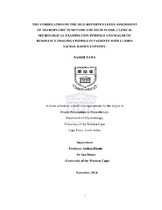| dc.description.abstract | Lumbo-sacral radiculopathy (LSR) is clinically defined as low back and referred leg symptoms accompanied by an objective sensory and/or motor deficit due to nerve root compromise. LSR is a common condition encountered by physiotherapists in clinical practice and the assessment and diagnosis remains a challenge owing to the complex anatomy of the lumbo-sacral spine segment and the various differentials. Moreover, LSR imposes a significant impact on patients’ health, functional ability, socio-economic status and quality of life. There are several diagnostic tools and procedures which are commonly utilised in practice, including diagnostic neuropathic pain screening questionnaires, clinical neurological tests, electro-diagnostics and imaging. However, the diagnostic utility and correlation of these tests have not been fully explored and remains debatable among clinicians and researchers in the fields of musculo-skeletal health and neurology. The aim of this study was to determine a correlation of the S-LANSS score, clinical neurological examination (CNE) findings and magnetic resonance imaging (MRI) reports in the diagnosis of LSR among patients who presented with low back and referred leg symptoms. The study was conducted in three phases. In phase one, two systematic literature reviews were conducted; firstly, to establish the evidence-based accuracy of CNE in diagnosing LSR, and secondly, to establish the evidence-based accuracy of MRI in diagnosing LSR. In both systematic literature reviews, the diagnostic tests accuracy (DTA) protocol was used in planning, design and execution of literature search, selection of relevant studies, quality assessment, data analysis and presentation of the results. In phase two, clinical validation of an adopted S-LANSS scale and lumbar MRI reporting protocol were established, and a standardised evidence based lumbar CNE protocol developed.The face and content validity of the original S-LANSS score was established among a sample of Kenyan physiotherapists and patients who presented with low back and referred leg symptoms, using both quantitative and qualitative research designs. This was followed by a test-re-test reliability study on the adapted version of the S- LNASS score. The face and content validity of the adopted lumbar MRI reporting protocol was established among a sample of Kenyan radiologists followed by an inter-rater reliability. An evidence-based lumbar CNE protocol was developed; standardised and inter-examiner reliability was also examined among a sample of Kenyan physiotherapists. Finally, in phase three, a cross-sectional blinded validity study was conducted in six different physiotherapy departments. Participants (patients, physiotherapists and radiologists) were recruited using strict in- and exclusion criteria and data was collected using a pain and demographic questionnaire, the S-LANSS scale, the CNE protocol, the Oswestry Disability Index (ODI) and the MRI lumbar spine reporting protocol. Data was captured, cleaned and analysed using SPSS version 21. Descriptive analysis was done using frequencies, means and percentages, while inferential analysis was conducted using Spearman’s rank correlation coefficient test r to establish the correlation between the diagnostic tests. Cross tabulations, receiver operating curves (ROC) and scatter plots were used to establish the sensitivity and/or specificity of S-LANSS scale and individual CNE tests as defined by MRI. In phase three, which formed the main study of the research project, a total of 102 participants were recruited in this study with a gender distribution of 57% females and 43% males. The majority (67%) had neuropathic pain according to the S-LANSS scale and their pain intensity ranged from moderate (4-6) to severe (7-9) as recorded on a Numeric Pain rating Scale (NPRS), and was more common among manual workers. Similarly, patients whose pain had a neuropathic component had moderate to severe disability. The S-LANSS scale and lower limb neuro-dynamic tests were the most sensitive tests 0.79 and 0.75 respectively, while deep tendon reflexes were the most specific tests (0.87). The S-LANSS and CNE correlated fairly but significantly with MRI (r=0.36, P=0.01).LSR is a common condition and its assessment and diagnosis remains a clinical challenge among physiotherapists. MRI is a high-cost diagnostic tool but is being used by many clinicians in making decisions regarding the management of patients. Rapid and low-cost neuropathic pain screening by the use of the S-LANSS scale, together with use of evidence-based CNE of neuro-conduction and neuro-dynamic tests may be used in confirming nerve-root related MRI findings. These may be used in making a decision on whether to manage a patient conservatively using pharmacological agents and manual physiotherapy and therapeutic exercise, or consider surgery in the initial management of patients with clinical suspicion of LSR. This is especially valuable in the resource-poor settings like Kenya and other sub-Saharan African countries where MRI is costly or unavailable. | en_US |

